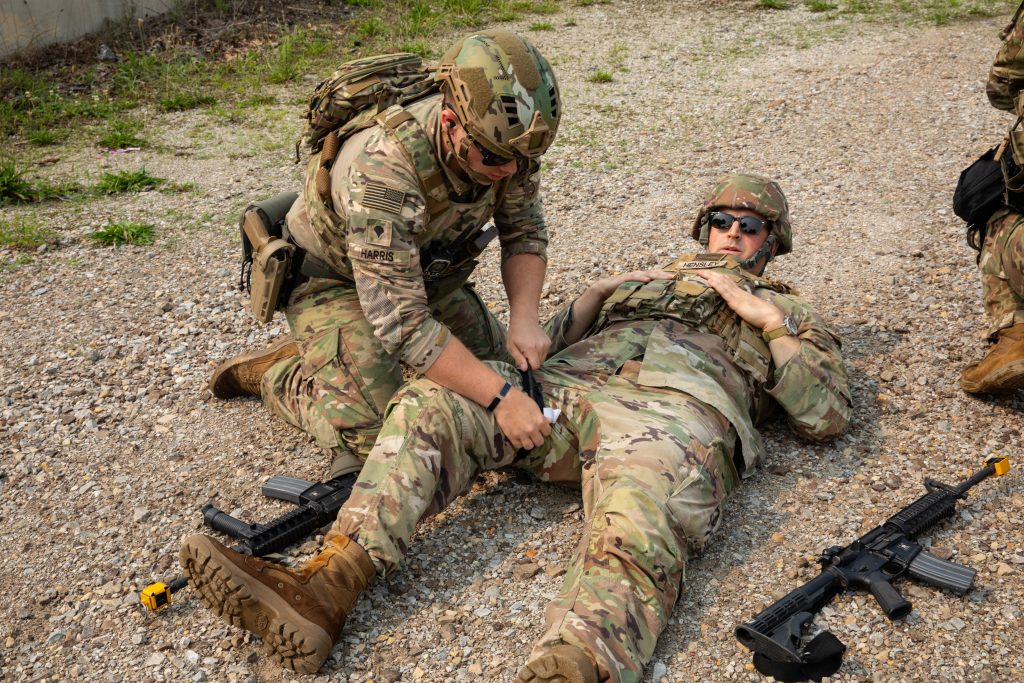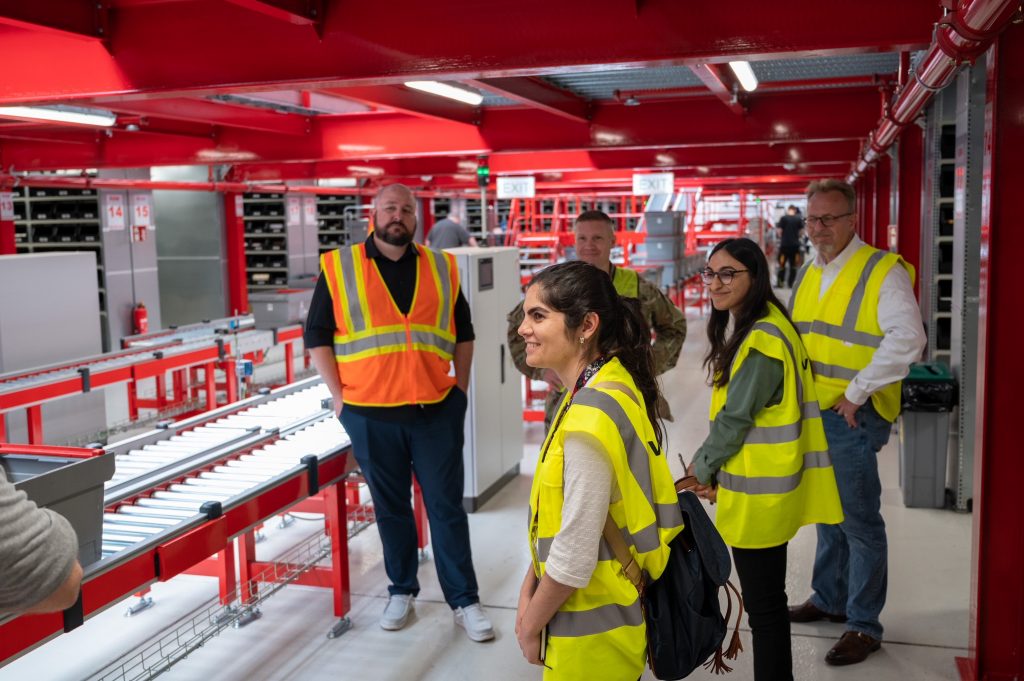
TIME IS TISSUE: U.S. Army Reserve Soldiers assigned to the 412th Civil Affairs Battalion and 5-159th Bourbon Dustoff conduct a medical evacuation simulation training exercise during Operation Viking at Muscatatuck, Indiana, July 2023. When a Soldier is injured on the battlefield, speed is often a critical factor as to whether they receive the medical attention and supplies they need to survive and return to the fight. (Photo by Sgt. Alexander Kelly, U.S. Army Reserve)
AMLC is using data to help decision-makers anticipate and position lifesaving materiel during large-scale combat operations.
by Joel Cook
In medicine, there is a saying that “time is tissue.” What this means is that when a Soldier falls sick or injured on the battlefield, speed is often a critical factor as to whether they survive and return to the fight. A key part of enabling health care at the speed of war is predicting what units will need, and then getting the right equipment and supplies in the right place at the right time—without grossly overestimating or underestimating. Overestimations are unsustainable and wasteful. Underestimations leave units fatally shorthanded.
The Army Medical Logistics Command (AMLC), the Army’s life cycle management command for medical materiel, is using data to help leaders plan for the complexity and lethality of large-scale combat operations, predicting what will be needed to sustain critical medical support to warfighters while also reducing resource waste.
DATA SCIENTISTS
There is a new breed of warriors that have become critical to Army modernization: data scientists. These specialists of facts and figures have joined the ranks of most parts of the Army, including AMLC’s Integrated Logistics Support Center, which introduced the 1560 Data Science job series into the organization in 2022. AMLC’s data scientists provide analysis and analytics services to AMLC’s organization, which includes teams of medical logisticians and maintainers at more than 25 sites worldwide.
Under the direction of the Integrated Logistics Support Center’s Logistics and Technical Support Directorate, they are aligning medical logistics with the whole-of-Army approach to use predictive logistics to deliver precision sustainment—reliable, agile and responsive sustainment capabilities that enhance materiel readiness, lower inventory consistent with the need to reduce demand, and reduce costs.
Predictive logistics refers to the Army’s ability to harness the power of data to forecast units’ needs, and then synchronize production and distribution at every echelon.
It’s not fortune telling. It’s science.
Data analytics provide leaders with real-time situational awareness of their current and future logistics readiness. From this common operating picture, they can predict logistical needs before the demand signal. For example, a demand signal could be a notification from a unit placing an order for more medications. However, the wait for the demand signal could mean the unit may be without critical resources for a period of time. This timing is critical in a contested, denied or disconnected environment where supplies may not be readily accessible or replenished.

LIFESAVING DATA: U.S. Army Reserve Spc. Matthew Harris, left, assigned to the 412th Civil Affairs Battalion, applies a tourniquet to 2nd Lt. Jarrad Hensley during a simulation training exercise at Operation Viking in Muscatatuck, Indiana, July 16, 2023. Predictive logistics can prevent units from being fatally unprepared. (Photo by Sgt. Alexander Kelly, U.S. Army Reserve)
DATA POWER
Data plays a critical role in sustaining large-scale combat operations and multidomain operations. Large-scale combat operations will consume supplies, devices and equipment at a higher rate, causing a significant increase on sustainment demands.
As a subordinate command under the U.S. Army Communications-Electronics Command, AMLC has taken an active role in modernization efforts such as the Army Materiel Command’s quarterly Predictive Logistics Summits. These summits bring together professionals from the Headquarters Army G-4, Training and Doctrine Command, Army Futures Command, U.S. Army Forces Command and the Office of the Assistant Secretary of the Army for Acquisition, Logistics and Technology to develop a comprehensive predictive logistics strategy to support the Army of 2030 and beyond.
For AMLC, the focus is keenly on synchronizing life cycle management for medical materiel into the Army sustainment enterprise. From there, AMLC is using artificial intelligence (AI) and machine learning (ML) to support effective commodity management. A necessary component of applying AI/ML technology is establishing a sound understanding of data, sources and connections.
Algorithm-dependent analysis requires access to clean, accurate and extensive historical data. AMLC’s medical logistics in campaigning effort is aimed at streamlining access to quality data by integrating materiel management, maintenance, distribution and information technology into established Army processes and systems. Like all other commodities and capabilities critical to the Army, medical must be captured in a consistent, standard format that supports the use of data in analytic models or algorithms. Without data accuracy, models and algorithms used by data scientists to support precision sustainment will produce fallible results.
To prepare for sustaining the Army of the future, AMLC’s data scientists use cloud-based systems, such as Army Vantage, to analyze data captured from diverse military programs and systems. Army Vantage is an enterprise data analytics platform enabling Army users at every echelon and classification level to view comprehensive Army-wide data, analyze trends and make real-time data-driven decisions.

STREAMLINE OPERATIONS: Members of U.S. Army Medical Logistics Command’s Integrated Logistics Support Center (ILSC) tour the U.S. Army Medical Materiel Center – Europe, May 2023. From left in yellow vests, data scientists Julia Contarino and Tajesvi Bhat, and Arthur Braithwaite, director of the ILSC’s Logistics and Technical Support Directorate. The data analysis team visited to learn more about operations, provide training and support the setup of an analytics dashboard to help streamline operations. (Photo courtesy of the author)
ANALYTICAL APPROACH
Data scientists often take multiple approaches to different challenges. At AMLC, data scientists are working on developing capabilities in three primary areas:
- Predictive maintenance: Using ML techniques to predict medical maintenance requirements before equipment failure. Predictive maintenance will improve medical equipment functionality and longevity while proactively supporting unit readiness for operational needs. Predictive maintenance will aid in identifying patterns and predicting the timing of the next materiel failure, as well as provide a possible solution (e.g., Equipment X is likely to fail in Y days for Z reason; replace part A with part B).
- Demand forecasting: Leveraging time-series forecasting algorithms to predict demand for future large-scale combat operations. Through historical orders and supply consumption data analysis, AMLC can ensure warehouses and Army prepositioned stock inventories reflect active requirements and can accommodate future demands. This effort supports reducing waste and diminishing the burden on the supply chain.
- Simulated scenarios: Simulating medical materiel requirements in various projected large-scale combat operations environments. By combining information on the effects of the scenario environment and supply consumption rates, these models help AMLC simulate the potential medical logistics landscape in large-scale combat operations.
AMLC’s end goal is to allow decision-makers at echelon to anticipate and position lifesaving materiel at necessary roles of care during large-scale combat operations. This involves accurately predicting medical needs of wounded warfighters based on locations, utilization rates and other vital information to optimize prioritization of medical materiel by type and quantity.
CONCLUSION
As the global stage evolves, maximizing the use of data to support informed decision-making becomes increasingly critical to not only staying ahead of our adversaries, but also staying within constrained resources. Data helps leaders make smart decisions. By aggregating multiple data sources from diverse systems into a singular cloud platform to support quality analysis, AMLC’s data scientists generate actionable insights.
What medical supplies are being rapidly consumed and what is excess? Which medical devices are most likely to need repair parts soon? When does the device need its next preventive maintenance service?
These insights also provide visibility into what, when and how things may break, as well as what may be needed to be replaced. In kind, this data can also tell us what we don’t need to buy—and this cost avoidance can return critical resources to the enterprise. If data tells the story, then data scientists are the writers—making meaning out of a mountain of information and giving leaders a tactical edge. That is why predictive logistics has become so critical to the Army’s ability to fight. Data is now the most decisive commodity because resources are not limitless, and time is not a renewable resource.
For more information, go to https://www.amlc.army.mil/.
JOEL COOK is a technical acquisition management specialist and serves as chief of the Technical Information Management Division’s Logistics and Technical Support Directorate for the AMLC Integrated Logistics Support Center. He holds a master’s in public administration from Brigham Young University and a B.S. in exercise physiology from Brigham Young University-Idaho.
CONTRIBUTORS:Tajesvi Bhat, senior data scientist at the AMLC Integrated Logistics Support Center’s Logistics and Technical Support Directorate; and Arthur Braithwaite, director of the Logistics and Technical Support Directorate of the AMLC Integrated Logistics Support Center.







